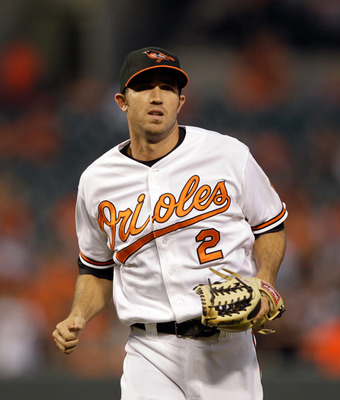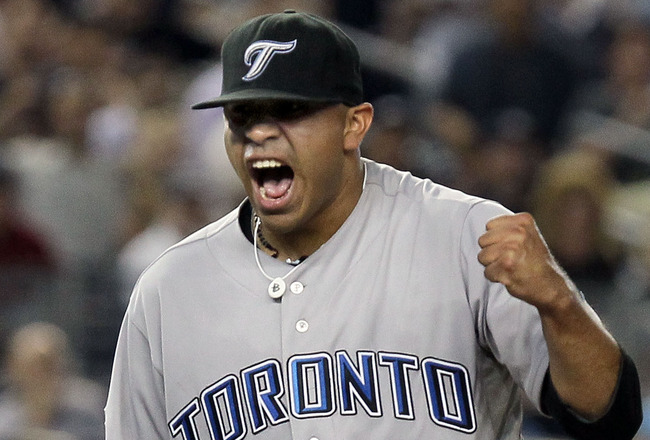 |
| Jose Reyes won the 2011 NL batting title. |
C Brian McCann, ATL (2nd)
Most importantly, McCann avoided becoming a hostage in Venezuela like one of his competition at this spot, Nationals catcher Wilson Ramos. McCann has been the most consistent catcher over the past half-decade, earning his sixth straight All-Star selection. His annual production of 20 homers and 70+ RBIs is welcome on a disjointed and aging Atlanta offense that has literally no speed outside of Michael Bourn only one other major power threat, the recent addition of Dan Uggla. Truth is, the Braves would be lost without McCann, but not even he could carry his tired team into the playoffs as the Braves blew their big wild card lead. Competition: Josh Thole (NYM), Carlos Ruiz (PHI), Wilson Ramos (WAS), John Buck (FLA).
1B Mike Morse, WAS
Where did this guy come from? Morse was ironically exactly what the Nationals expected out of Jayson Werth, who was hampered by injury and had a down season. The 29-year-old Morse got his first full season in 2011, but few expected such a breakout. Morse had never even hit 20 homers in a minor league season, and he comes out with 31 for Washington. He also became a team leader along the way. Competition: Ryan Howard (PHI), Gaby Sanchez (FLA), Freddie Freeman (ATL), and Daniel Murphy (NYM).
2B Dan Uggla, ATL (2nd, first with Braves)
In a season highlighted by a 34-game hitting streak, Uggla batted only .233. That is probably the last time we will see such a low average from a 30-game hit streak player. But as stated in the McCann argument, the Braves offense would be near incompetent without Uggla. The Braves don't really have any other dynamic power hitters, as other pieces like Martin Prado, Chipper Jones, Freddie Freeman and Alex Gonzalez really only have power as an extra bonus to their hitting-for-average skills. It took Uggla a long time to get going in 2011, but the power was there and kept them afloat in the NL East.
3B Chipper Jones, ATL
In another position smashed by injury, David Wright and Ryan Zimmerman both missed significant time. Jones, in his age 39 season, is a shadow of the player he once was, which is quite depressing to be honest. Jones has his job for as long as he wants it out of respect from the Braves, but his offensive skills are limited. Just 18 homers and 70 RBIs came off his bat in 2011, but he's obviously still a team leader and loved by his fans. Competition: David Wright (NYM), Ryan Zimmerman (WAS), Greg Dobbs (FLA), Placido Polanco (PHI).
SS Jose Reyes, NYM
Unfortunately, Reyes' season ended in controversy when he got a bunt single in the last game of the season and took himself out of the lineup in the last game of the season to ensure the greatest chance at a batting title. Ryan Braun failed to do the impossible, and Reyes won the first batting title in Mets history. A return to the Mets looks far fetched, so Reyes is sure to cash in big soon. Most impressive? In 586 plate appearances, he walked 43 times and struck out 41 times, an 86% contact rate! Competition: Ian Desmond (WAS), Hanley Ramirez (FLA), Jimmy Rollins (PHI), and Alex Gonzalez (ATL).
LF Logan Morrison, FLA
Lo-Mo finally was disciplined for his Twitter tendencies in 2011, and his relationship with the front office is unclear. Morrison was sent to the minors temporarily for bad off-field conduct (specifically, Twitterness) and promptly filed a grievance with the players association. Trade rumors involving the budding star heated up, but he was a runway model for the Marlins' new uniforms presentation at the new ballpark, confirming his status as an integral part of the team core. The ever-changing Marlins roster doesn't have much of an established core outside of Hanley Ramirez, but I still believe Lo-Mo will definitely be a Miami Marlin next season. Competition: Jason Bay (NYM), Raul Ibanez (PHI), Martin Prado (ATL), and Laynce Nix (WAS).
CF Angel Pagan, NYM (2nd)
He doesn't bat as well or walk as much as the ideal leadoff man, but Pagan does a fine job in center field for the Mets. After being superb defensively in 2010, Pagan really struggled in 2011 at times. However, 32 steals got the job done in his role behind Reyes. He serves as a fine table setter at a relatively cheap price. He's never going to be an All-Star but he fits this team fine. And finally, his speed role will be magnified with the departure of Reyes next season. Competition: Shane Victorino (PHI), Chris Coghlan (FLA), Nate McLouth (ATL), and Rick Ankiel (WAS).
RF Mike Stanton, FLA (2nd)
Stanton's home runs soar higher than the voices of the Marlins TV announcers (which is hard to do) with great regularity. The 21-year-old has all the looks of a major power hitter for years to come. The Marlins are currently being aggressive in the free agent market for the first time in their history, but if they plan to win, they'll need Stanton, who is already an elite outfielder. And fantasy draftee. Competition: Jason Heyward (ATL), Hunter Pence (PHI), Carlos Beltran (NYM), and Jayson Werth (WAS).
SP Roy Halladay, PHI
Dealing with a loss of confidence at the plate? This Doc won't help with that. Roy Halladay was the best of three Phillies starters with ERAs below 3.00 and decreased his homer total from 24 to 10. He threw eight complete games and one shutout with the lowest ERA of his career at 2.35. Even with ridiculous stamina and decent run support, Halladay failed to win 20 games which could even be seen as a surprise. However, starting pitcher wins are overrated. Bottom line: Halladay's a beast for the time being. Competition: Anibal Sanchez (FLA), R.A. Dickey (NYM), Tim Hudson (ATL), and John Lannan (WAS).
CP Craig Kimbrel, ATL
127 strikeouts. In 77 innings. In his first full season as closer, Kimbrel was the best at the position in MLB. As I've said in earlier posts, Kimbrel didn't allow a run for a stretch of about two and a half months in the middle of summer and only allowed three homers all year. The Braves have the best bullpen in MLB and actually have three options at closer in Eric O'Flaherty, Jonny Venters, and Kimbrel. The chances are that any of the three of them would have been the best in the league no matter who was chosen as closer. For 2011, though, Kimbrel was the best in the business in talent. Somehow, however, he blew eight saves along the way and the biggest one of the season, the one that would've gotten them to a Wild Card tiebreaker. Three blown saves in September helped the Braves collapse hard. Competition: Francisco Rodriguez (NYM), Ryan Madson (PHI), Juan Oviedo (FLA), and Drew Storen (WAS).











